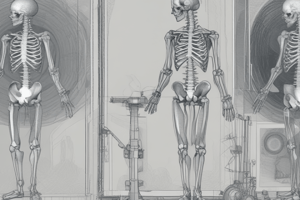Podcast
Questions and Answers
Why does radiographic film fail to adequately demonstrate slight differences in subject contrast?
Why does radiographic film fail to adequately demonstrate slight differences in subject contrast?
- Because radiographic film is too sensitive and blurs out subtle differences.
- Because typical film-screen combinations can only discriminate x-ray intensity differences of 5% to 10%. (correct)
- Because radiographic film has the ability to adjust contrast after recording.
- Because radiography and tomography cannot generate cross-sectional images.
How does CT imaging differ from radiography in terms of imaging capabilities?
How does CT imaging differ from radiography in terms of imaging capabilities?
- CT imaging offers the ability to adjust contrast after recording.
- CT imaging is less sensitive to subtle differences in tissue contrast.
- CT imaging can generate cross-sectional images without superimposition of structures. (correct)
- CT imaging uses film-screen combinations for image acquisition.
What is a key advantage of CT scans over traditional radiography for imaging purposes?
What is a key advantage of CT scans over traditional radiography for imaging purposes?
- CT scans provide the ability to reformulate images in multiple planes. (correct)
- CT scans use the same film-screen combinations as radiography.
- CT scans are less detailed than radiographic images.
- CT scans have lower sensitivity to subtle tissue contrast differences.
How does the sensitivity of CT imaging compare to screen-film recording systems in terms of x-ray attenuation differences?
How does the sensitivity of CT imaging compare to screen-film recording systems in terms of x-ray attenuation differences?
Why is it mentioned that CT scans can be used for nondestructive materials testing and studying biological specimens?
Why is it mentioned that CT scans can be used for nondestructive materials testing and studying biological specimens?




